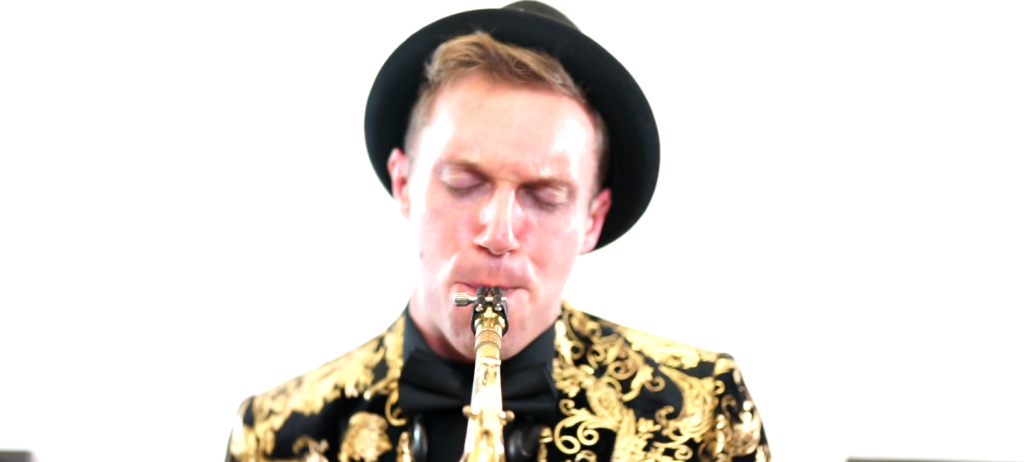One instrument with which you might find yourself coming into contact increasingly of late is the
solo saxophone. In an era dominated by electronic music, amidst educators bemoaning the lack of
interest in traditional instruments, this might seem an unlikely state of affairs. But here at High Row
we’re finding our solo saxophonists more and more in demand, and it’s worth having a little think
about why.
The saxophone, unlike its counterparts (clarinets, flutes) and rivals (brass and stringed instruments)
is the relative new kid on the block, invented less than two hundred years ago by a man named
Adolphe Sax, who perhaps had a premonition that the Adolfone might not get the same take up.
Because of this, it has little of the heritage of other acoustic instruments – the likes of Bach, Mozart
& Beethoven were never able to write for it – and though some contemporary composers in the
nineteenth century tried to incorporate it into their classical pieces, it really did stand out like a sore
thumb, and never found a home in the orchestra. Saxophone teaching, begun only in the 1850s, was
suspended at the Paris Conservatory from 1870 to the end of the century. So how did it survive?
Well, when Mr Sax invented it, he was effectively trying to create an instrument that had the
versatility of the clarinet, but the projection of a trumpet – in other words, a loud thing for showing
off. And what organisation flexes any louder than a military marching band? The ability of the sax
to be a portable bazooka of sound that you could play all day without getting as tired as brass
instruments appealed greatly to the marching band community, and in the early twentieth century,
this is where things kicked off. Soon, it got taken up by the vaudeville and jazz scenes, and bit by
bit this loud and showy instrument began to gain some sex appeal too. Indeed, there are some who
speculate that the word sex actually comes from the word sax. [Ed: there is no evidence of this]
The saxophone took over from the trumpet as the primary instrument of the jazz scene, and as jazz,
blues, and R&B morphed into Rock and Roll in the late 50s, the saxophone managed to keep its
place as the sole acoustic instrument in an increasingly electronic musical world. And it only
seemed to go from strength to strength. The sixties? How about The Beatles’ & Lady Madonna.
Seventies? Bruce Springsteen’s Born to Run or Gerry Rafferty’s anthemic Baker Street. The
eighties continued to grow – Bill Withers’ Just the two of us, Medley &Warnes (I’ve had) The time
of my life and of course, the apex of the sexy sax, George Michael’ Careless Whisper
But then the nineties happened. As it became possible for people to consume music more and more
readily (and increasingly, visually) at home, and attention spans consequently shortened, the
saxophone, with its tendency to play riffs or solos, became less and less relevant. Rock music
tended to strip right down to guitars, basses and drums, and pop bands, if they did exist, tended to
consist exclusively of vocalists. Developments in synthesisers meant that if a hook did need to be
played, it could all be done electronically, meaning fewer musicians to pay, and squeezing more
money into the pockets of canny maximalist producers.
The noughties took this reduction of personnel one step further, and many electronic artists and
duos began to exist without even having a singer as a member, relying instead on samples or at best
guest vocalists for one song. It is at this point in history that we tend to believe we still are – that
instrumental playing is dead, and everything is electronic now. And, well, you could be forgiven for
thinking that. Even in our industry of event music a lot of clients are choosing to have a DJ provide
all the musical entertainment. But actually, this is far from the whole story.
Thanks to a combination of most folks’ increasing ability to access any genre or period of music any
time they wanted alongside this general feeling that modern pop music was somehow dying or less
authentic than it used to be, rather than looking forward, people started to have a resurgent interest
in older styles of music. Think about it, once you’ve reduced a twenty-piece orchestra down to one
person with a laptop, where can you go after that? And so in the 2010s, we began our love affair
with retro and vintage.
A few artists are particularly responsible here – Postmodern Jukebox revived an interest in jazz and
swing, Amy Winehouse, together with producer Mark Ronson reminded us of the horn-heavy
motown sound, and even Katy Perry found space for SNL band MD and Tower of Power sax
superstar Lenny Pickett (albeit mimed by Kenny G) on her track Last Friday Night (T.G.I.F). But
the trend was universal, as people started to look back at older styles of recorded music for
something more authentic to add to current electronic music, what did they see? Why, the acoustic
superstar of a century of popular music. The saxophone. In a period of financial uncertainty, if
you've the budget to add one more musician to the party at your event, what’s it going to be? A
violin? Too quiet. A trombone? Not versatile enough. A trumpet? Not nearly enough hip-thrusting
(again, I urge you to watch this https://www.youtube.com/watch?v=GaoLU6zKaws) – nope, it’s the
saxophone.
This is where we at High Row can help – our saxophonists know the genre inside out, and are ready
to add exactly that certain je ne sais quois to your event.
